Marketing Consumer Behavior Report
VerifiedAdded on 2020/04/15
|19
|4026
|197
AI Summary
Contribute Materials
Your contribution can guide someone’s learning journey. Share your
documents today.

Running head: MARKETING CONSUMER BEHAVIOUR
Marketing Consumer Behavior
Name of the Student:
Name of the University:
Author Note:
Marketing Consumer Behavior
Name of the Student:
Name of the University:
Author Note:
Secure Best Marks with AI Grader
Need help grading? Try our AI Grader for instant feedback on your assignments.

1MARKETING CONSUMER BEHAVIOUR
Executive Summary:
The report aims at providing an overview of marketing consumer behavior of the Golf model of
Volkswagen Singapore that represents a high involvement car brand. Thus, in order to explain
this, there is a description of the company background along with a SWOT and PESTEL analysis
mentioned in the report. There is a description of the target market and its decision making
process that also finds a mention in the report. The report also has an evaluation of alternatives.
There is a description of the purchase decision and evaluation of the post purchase decision in
terms of social, psychological and personal influence. One can find recommendations on the
marketing strategy along with its four Ps and its influence by the social, psychological and
personal influence mentioned in the report.
Executive Summary:
The report aims at providing an overview of marketing consumer behavior of the Golf model of
Volkswagen Singapore that represents a high involvement car brand. Thus, in order to explain
this, there is a description of the company background along with a SWOT and PESTEL analysis
mentioned in the report. There is a description of the target market and its decision making
process that also finds a mention in the report. The report also has an evaluation of alternatives.
There is a description of the purchase decision and evaluation of the post purchase decision in
terms of social, psychological and personal influence. One can find recommendations on the
marketing strategy along with its four Ps and its influence by the social, psychological and
personal influence mentioned in the report.

2MARKETING CONSUMER BEHAVIOUR
Table of Contents
1. Company Background.................................................................................................................4
2. Situation Analysis.......................................................................................................................5
Company PESTEL...........................................................................................................................5
SWOT Analysis...............................................................................................................................7
3. Target Market Description...........................................................................................................8
4. Target Market Decision Making Process....................................................................................9
1. Problem Recognition................................................................................................................9
a. Market Induced.....................................................................................................................9
b. New Stage in Life.................................................................................................................9
2. Information Search.................................................................................................................10
a. Level of Risk......................................................................................................................10
b. Level of Product Knowledge..............................................................................................10
3. Evaluation of Alternatives.....................................................................................................11
a. List of Evoked Set and Why...............................................................................................11
b. Compensatory and Non compensatory Rules....................................................................11
4. Purchase Decision......................................................................................................................12
a. Availability of the product/substitute product....................................................................12
b. Retail Factors......................................................................................................................12
Table of Contents
1. Company Background.................................................................................................................4
2. Situation Analysis.......................................................................................................................5
Company PESTEL...........................................................................................................................5
SWOT Analysis...............................................................................................................................7
3. Target Market Description...........................................................................................................8
4. Target Market Decision Making Process....................................................................................9
1. Problem Recognition................................................................................................................9
a. Market Induced.....................................................................................................................9
b. New Stage in Life.................................................................................................................9
2. Information Search.................................................................................................................10
a. Level of Risk......................................................................................................................10
b. Level of Product Knowledge..............................................................................................10
3. Evaluation of Alternatives.....................................................................................................11
a. List of Evoked Set and Why...............................................................................................11
b. Compensatory and Non compensatory Rules....................................................................11
4. Purchase Decision......................................................................................................................12
a. Availability of the product/substitute product....................................................................12
b. Retail Factors......................................................................................................................12

3MARKETING CONSUMER BEHAVIOUR
5. Post Purchase Evaluation...........................................................................................................13
a. Post Purchase Feelings- Happy, neutral and not happy.........................................................13
b. Post purchase cognitive dissonance and handling Consumers and Marketers Point of view13
6. Two Social Influences...............................................................................................................14
a. Family - Family Decision Making Process............................................................................14
b. Social Class- Influence of Social Class on Decision Making Process...................................14
7. Psychological Influences...........................................................................................................15
a. Motivation..............................................................................................................................15
b. Perception...............................................................................................................................15
c. Learning.................................................................................................................................15
8. Two Personal Influences............................................................................................................15
a. Personality..............................................................................................................................15
b. Age.........................................................................................................................................16
9. Marketing Strategy Recommendations......................................................................................16
Conclusion.....................................................................................................................................17
References......................................................................................................................................17
5. Post Purchase Evaluation...........................................................................................................13
a. Post Purchase Feelings- Happy, neutral and not happy.........................................................13
b. Post purchase cognitive dissonance and handling Consumers and Marketers Point of view13
6. Two Social Influences...............................................................................................................14
a. Family - Family Decision Making Process............................................................................14
b. Social Class- Influence of Social Class on Decision Making Process...................................14
7. Psychological Influences...........................................................................................................15
a. Motivation..............................................................................................................................15
b. Perception...............................................................................................................................15
c. Learning.................................................................................................................................15
8. Two Personal Influences............................................................................................................15
a. Personality..............................................................................................................................15
b. Age.........................................................................................................................................16
9. Marketing Strategy Recommendations......................................................................................16
Conclusion.....................................................................................................................................17
References......................................................................................................................................17
Secure Best Marks with AI Grader
Need help grading? Try our AI Grader for instant feedback on your assignments.
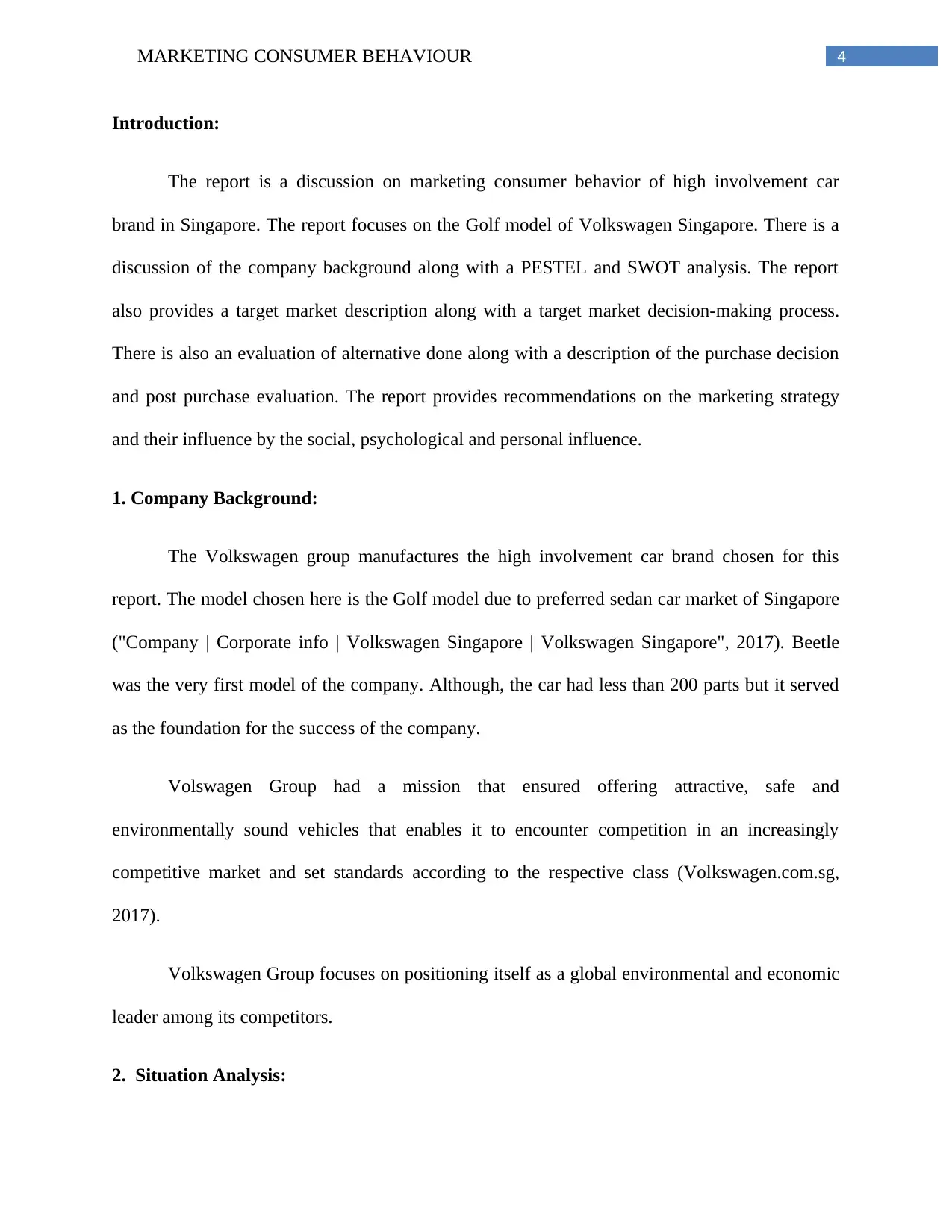
4MARKETING CONSUMER BEHAVIOUR
Introduction:
The report is a discussion on marketing consumer behavior of high involvement car
brand in Singapore. The report focuses on the Golf model of Volkswagen Singapore. There is a
discussion of the company background along with a PESTEL and SWOT analysis. The report
also provides a target market description along with a target market decision-making process.
There is also an evaluation of alternative done along with a description of the purchase decision
and post purchase evaluation. The report provides recommendations on the marketing strategy
and their influence by the social, psychological and personal influence.
1. Company Background:
The Volkswagen group manufactures the high involvement car brand chosen for this
report. The model chosen here is the Golf model due to preferred sedan car market of Singapore
("Company | Corporate info | Volkswagen Singapore | Volkswagen Singapore", 2017). Beetle
was the very first model of the company. Although, the car had less than 200 parts but it served
as the foundation for the success of the company.
Volswagen Group had a mission that ensured offering attractive, safe and
environmentally sound vehicles that enables it to encounter competition in an increasingly
competitive market and set standards according to the respective class (Volkswagen.com.sg,
2017).
Volkswagen Group focuses on positioning itself as a global environmental and economic
leader among its competitors.
2. Situation Analysis:
Introduction:
The report is a discussion on marketing consumer behavior of high involvement car
brand in Singapore. The report focuses on the Golf model of Volkswagen Singapore. There is a
discussion of the company background along with a PESTEL and SWOT analysis. The report
also provides a target market description along with a target market decision-making process.
There is also an evaluation of alternative done along with a description of the purchase decision
and post purchase evaluation. The report provides recommendations on the marketing strategy
and their influence by the social, psychological and personal influence.
1. Company Background:
The Volkswagen group manufactures the high involvement car brand chosen for this
report. The model chosen here is the Golf model due to preferred sedan car market of Singapore
("Company | Corporate info | Volkswagen Singapore | Volkswagen Singapore", 2017). Beetle
was the very first model of the company. Although, the car had less than 200 parts but it served
as the foundation for the success of the company.
Volswagen Group had a mission that ensured offering attractive, safe and
environmentally sound vehicles that enables it to encounter competition in an increasingly
competitive market and set standards according to the respective class (Volkswagen.com.sg,
2017).
Volkswagen Group focuses on positioning itself as a global environmental and economic
leader among its competitors.
2. Situation Analysis:
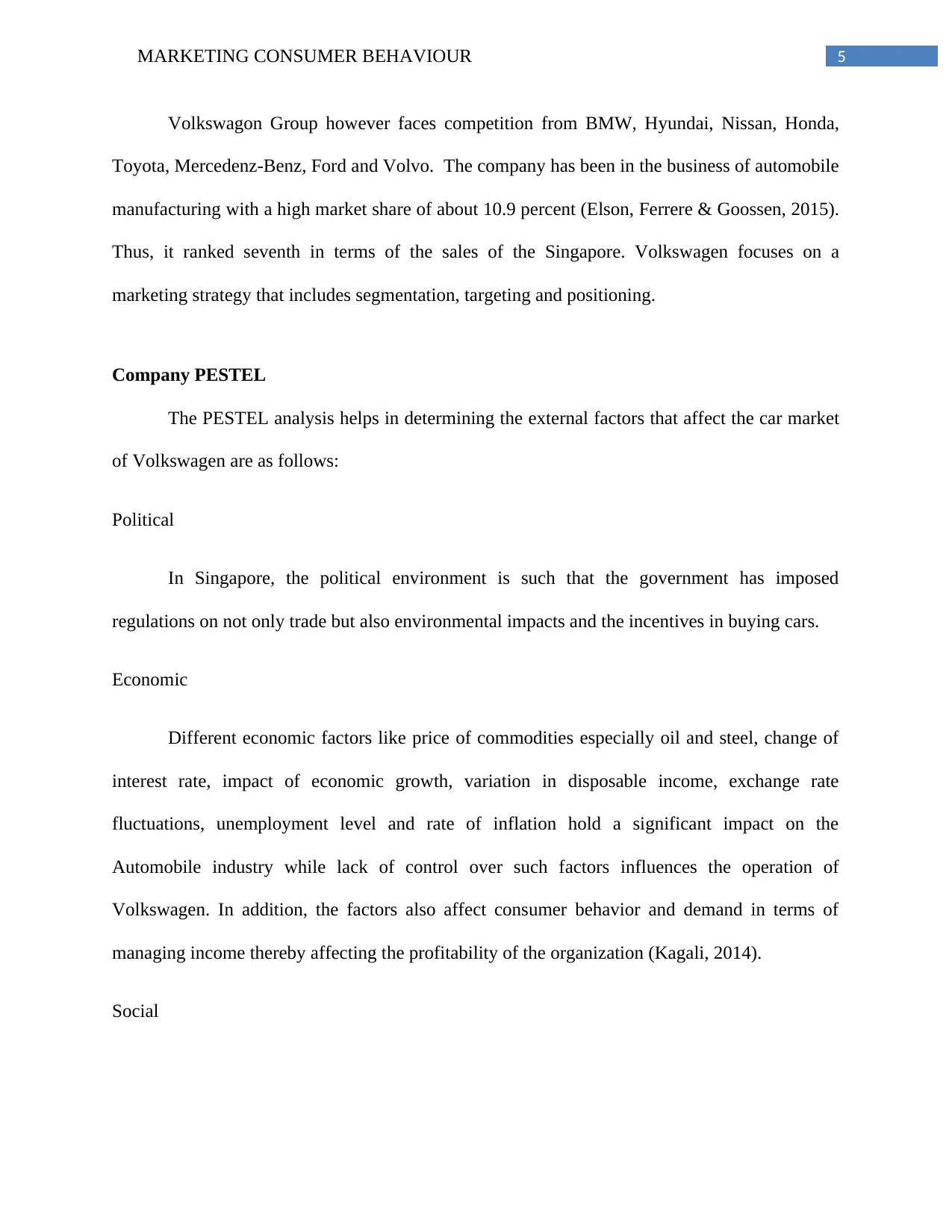
5MARKETING CONSUMER BEHAVIOUR
Volkswagon Group however faces competition from BMW, Hyundai, Nissan, Honda,
Toyota, Mercedenz-Benz, Ford and Volvo. The company has been in the business of automobile
manufacturing with a high market share of about 10.9 percent (Elson, Ferrere & Goossen, 2015).
Thus, it ranked seventh in terms of the sales of the Singapore. Volkswagen focuses on a
marketing strategy that includes segmentation, targeting and positioning.
Company PESTEL
The PESTEL analysis helps in determining the external factors that affect the car market
of Volkswagen are as follows:
Political
In Singapore, the political environment is such that the government has imposed
regulations on not only trade but also environmental impacts and the incentives in buying cars.
Economic
Different economic factors like price of commodities especially oil and steel, change of
interest rate, impact of economic growth, variation in disposable income, exchange rate
fluctuations, unemployment level and rate of inflation hold a significant impact on the
Automobile industry while lack of control over such factors influences the operation of
Volkswagen. In addition, the factors also affect consumer behavior and demand in terms of
managing income thereby affecting the profitability of the organization (Kagali, 2014).
Social
Volkswagon Group however faces competition from BMW, Hyundai, Nissan, Honda,
Toyota, Mercedenz-Benz, Ford and Volvo. The company has been in the business of automobile
manufacturing with a high market share of about 10.9 percent (Elson, Ferrere & Goossen, 2015).
Thus, it ranked seventh in terms of the sales of the Singapore. Volkswagen focuses on a
marketing strategy that includes segmentation, targeting and positioning.
Company PESTEL
The PESTEL analysis helps in determining the external factors that affect the car market
of Volkswagen are as follows:
Political
In Singapore, the political environment is such that the government has imposed
regulations on not only trade but also environmental impacts and the incentives in buying cars.
Economic
Different economic factors like price of commodities especially oil and steel, change of
interest rate, impact of economic growth, variation in disposable income, exchange rate
fluctuations, unemployment level and rate of inflation hold a significant impact on the
Automobile industry while lack of control over such factors influences the operation of
Volkswagen. In addition, the factors also affect consumer behavior and demand in terms of
managing income thereby affecting the profitability of the organization (Kagali, 2014).
Social

6MARKETING CONSUMER BEHAVIOUR
The culture and trends of the Singapore society have an impact on the choice and usage
of not only the choice of automobile industry but also the cars they choose. Singapore is a
country that is conscious about its image portrayal along with concern for carbon footprint and
the brand image of automobiles that affects the consumer choice (Steilmann, 2014).
Technological
The innovations of the technological advancements have put forward opportunities for
not only improving and redesigning the production process but also the operating infrastructure.
This leads to improvement in product quality, lower associated cost and greater efficiency of the
products. Thus, with commencement of technological advancements there is creation of
alternative sources of fuel, reduction in carbon emission, inclusion of internet enabled GPS
technologies for automobiles and a preference for driverless technology.
Environmental
The society in Singapore is conscious of its environment and therefore measures the level
of carbon footprints of its vehicles that also determines the choice for its automobile.
Legal
There are certain legal implications that call for a stricter business ambience Singapore
and affect the buying behavior of the consumers. These laws include the import laws that pose
restrictions on the import of automobiles (Kagali, 2014). There are government tax laws that
limit the number of cars plying on road. In Singapore, there are also tax rebates for vehicles that
are eco friendly. Further, there also exists penalty for carbon surcharge and standards for vehicle
emissions.
The culture and trends of the Singapore society have an impact on the choice and usage
of not only the choice of automobile industry but also the cars they choose. Singapore is a
country that is conscious about its image portrayal along with concern for carbon footprint and
the brand image of automobiles that affects the consumer choice (Steilmann, 2014).
Technological
The innovations of the technological advancements have put forward opportunities for
not only improving and redesigning the production process but also the operating infrastructure.
This leads to improvement in product quality, lower associated cost and greater efficiency of the
products. Thus, with commencement of technological advancements there is creation of
alternative sources of fuel, reduction in carbon emission, inclusion of internet enabled GPS
technologies for automobiles and a preference for driverless technology.
Environmental
The society in Singapore is conscious of its environment and therefore measures the level
of carbon footprints of its vehicles that also determines the choice for its automobile.
Legal
There are certain legal implications that call for a stricter business ambience Singapore
and affect the buying behavior of the consumers. These laws include the import laws that pose
restrictions on the import of automobiles (Kagali, 2014). There are government tax laws that
limit the number of cars plying on road. In Singapore, there are also tax rebates for vehicles that
are eco friendly. Further, there also exists penalty for carbon surcharge and standards for vehicle
emissions.
Paraphrase This Document
Need a fresh take? Get an instant paraphrase of this document with our AI Paraphraser
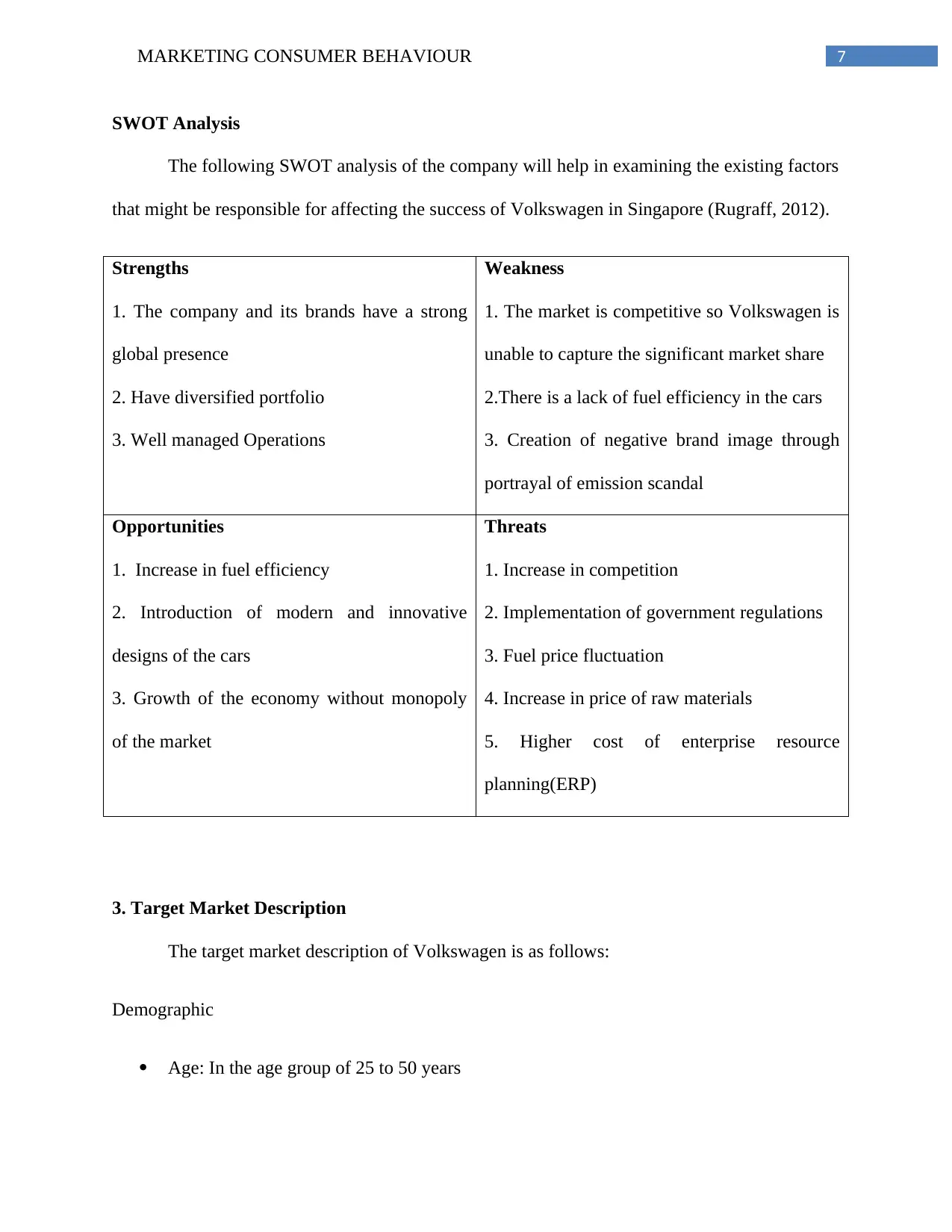
7MARKETING CONSUMER BEHAVIOUR
SWOT Analysis
The following SWOT analysis of the company will help in examining the existing factors
that might be responsible for affecting the success of Volkswagen in Singapore (Rugraff, 2012).
Strengths
1. The company and its brands have a strong
global presence
2. Have diversified portfolio
3. Well managed Operations
Weakness
1. The market is competitive so Volkswagen is
unable to capture the significant market share
2.There is a lack of fuel efficiency in the cars
3. Creation of negative brand image through
portrayal of emission scandal
Opportunities
1. Increase in fuel efficiency
2. Introduction of modern and innovative
designs of the cars
3. Growth of the economy without monopoly
of the market
Threats
1. Increase in competition
2. Implementation of government regulations
3. Fuel price fluctuation
4. Increase in price of raw materials
5. Higher cost of enterprise resource
planning(ERP)
3. Target Market Description
The target market description of Volkswagen is as follows:
Demographic
Age: In the age group of 25 to 50 years
SWOT Analysis
The following SWOT analysis of the company will help in examining the existing factors
that might be responsible for affecting the success of Volkswagen in Singapore (Rugraff, 2012).
Strengths
1. The company and its brands have a strong
global presence
2. Have diversified portfolio
3. Well managed Operations
Weakness
1. The market is competitive so Volkswagen is
unable to capture the significant market share
2.There is a lack of fuel efficiency in the cars
3. Creation of negative brand image through
portrayal of emission scandal
Opportunities
1. Increase in fuel efficiency
2. Introduction of modern and innovative
designs of the cars
3. Growth of the economy without monopoly
of the market
Threats
1. Increase in competition
2. Implementation of government regulations
3. Fuel price fluctuation
4. Increase in price of raw materials
5. Higher cost of enterprise resource
planning(ERP)
3. Target Market Description
The target market description of Volkswagen is as follows:
Demographic
Age: In the age group of 25 to 50 years
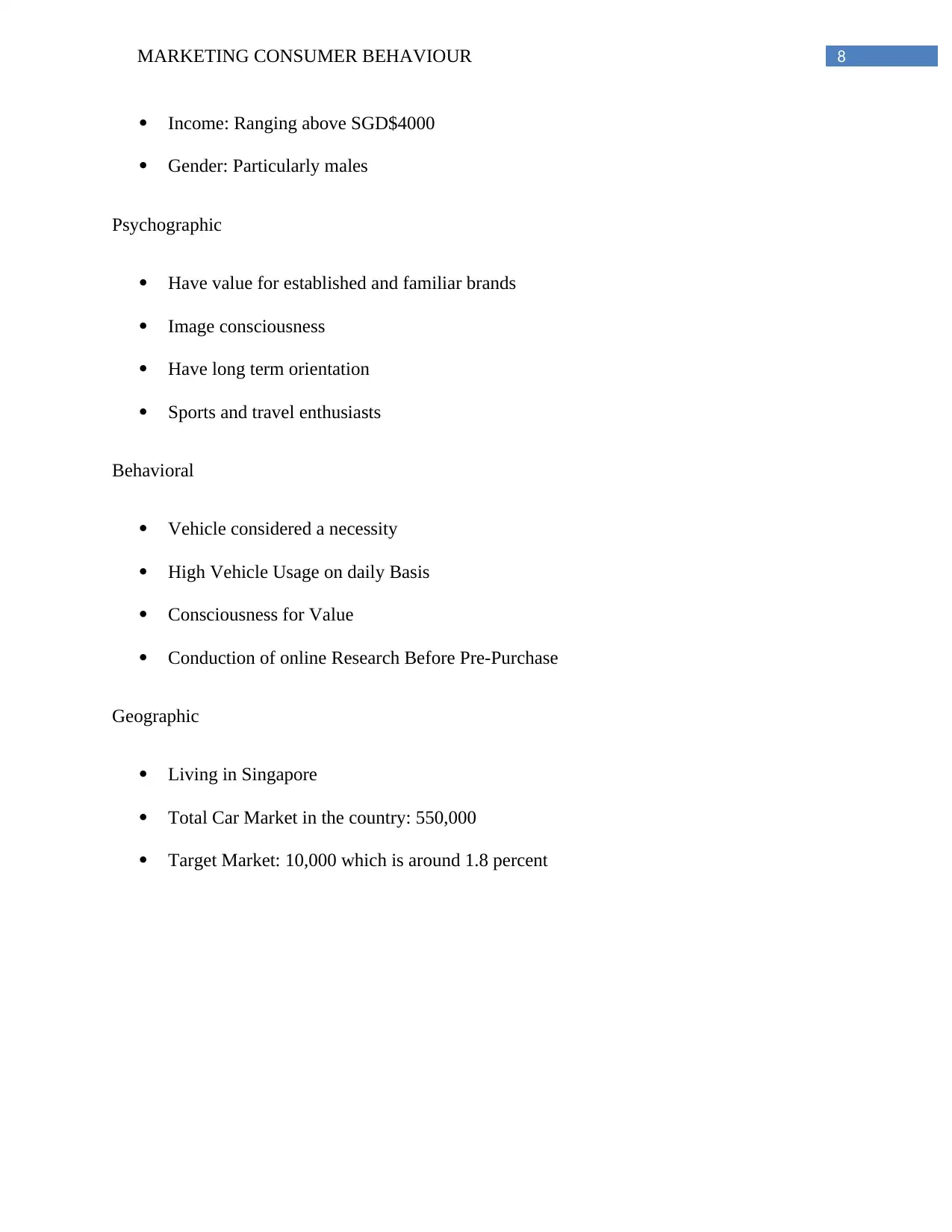
8MARKETING CONSUMER BEHAVIOUR
Income: Ranging above SGD$4000
Gender: Particularly males
Psychographic
Have value for established and familiar brands
Image consciousness
Have long term orientation
Sports and travel enthusiasts
Behavioral
Vehicle considered a necessity
High Vehicle Usage on daily Basis
Consciousness for Value
Conduction of online Research Before Pre-Purchase
Geographic
Living in Singapore
Total Car Market in the country: 550,000
Target Market: 10,000 which is around 1.8 percent
Income: Ranging above SGD$4000
Gender: Particularly males
Psychographic
Have value for established and familiar brands
Image consciousness
Have long term orientation
Sports and travel enthusiasts
Behavioral
Vehicle considered a necessity
High Vehicle Usage on daily Basis
Consciousness for Value
Conduction of online Research Before Pre-Purchase
Geographic
Living in Singapore
Total Car Market in the country: 550,000
Target Market: 10,000 which is around 1.8 percent

9MARKETING CONSUMER BEHAVIOUR
4. Target Market Decision Making Process
1. Problem Recognition
a. Market Induced
There is encouragement from the marketers that influences the consumers to be
dissatisfied with the present situation that leads to the creation of new wants and needs.
Volkswagen tries to capture this aspect of consumer behavior by introducing new products
(Ingram et.al 2012). This arouses the interest of the customers in the newly introduced car brand.
b. New Stage in Life
Volkswagon targets the customers in the age group of 25 and above. This is a stage in the
life of a person where he forms an idea about himself. Moreover, this is a stage when people
have a stable disposal income and starts thinking of starting a family (Gurău, 2012). This stage
also makes the person brand conscious and leaves him in a position where he is most
comfortable and acts as a deciding factor for making purchase.
2. Information Search
a. Level of Risk
However, before making a purchase decision each consumer will determine the level of
risk. This risk involves technical risk, service risk, social risk, time risk, financial risk,
psychological risk, and brand and product risk (Henthorne, George & Smith, 2013).
b. Level of Product Knowledge
The information about the product is important for driving the shopping experience of the
consumers. Various websites can contribute to enhancing the level of knowledge regarding the
4. Target Market Decision Making Process
1. Problem Recognition
a. Market Induced
There is encouragement from the marketers that influences the consumers to be
dissatisfied with the present situation that leads to the creation of new wants and needs.
Volkswagen tries to capture this aspect of consumer behavior by introducing new products
(Ingram et.al 2012). This arouses the interest of the customers in the newly introduced car brand.
b. New Stage in Life
Volkswagon targets the customers in the age group of 25 and above. This is a stage in the
life of a person where he forms an idea about himself. Moreover, this is a stage when people
have a stable disposal income and starts thinking of starting a family (Gurău, 2012). This stage
also makes the person brand conscious and leaves him in a position where he is most
comfortable and acts as a deciding factor for making purchase.
2. Information Search
a. Level of Risk
However, before making a purchase decision each consumer will determine the level of
risk. This risk involves technical risk, service risk, social risk, time risk, financial risk,
psychological risk, and brand and product risk (Henthorne, George & Smith, 2013).
b. Level of Product Knowledge
The information about the product is important for driving the shopping experience of the
consumers. Various websites can contribute to enhancing the level of knowledge regarding the
Secure Best Marks with AI Grader
Need help grading? Try our AI Grader for instant feedback on your assignments.
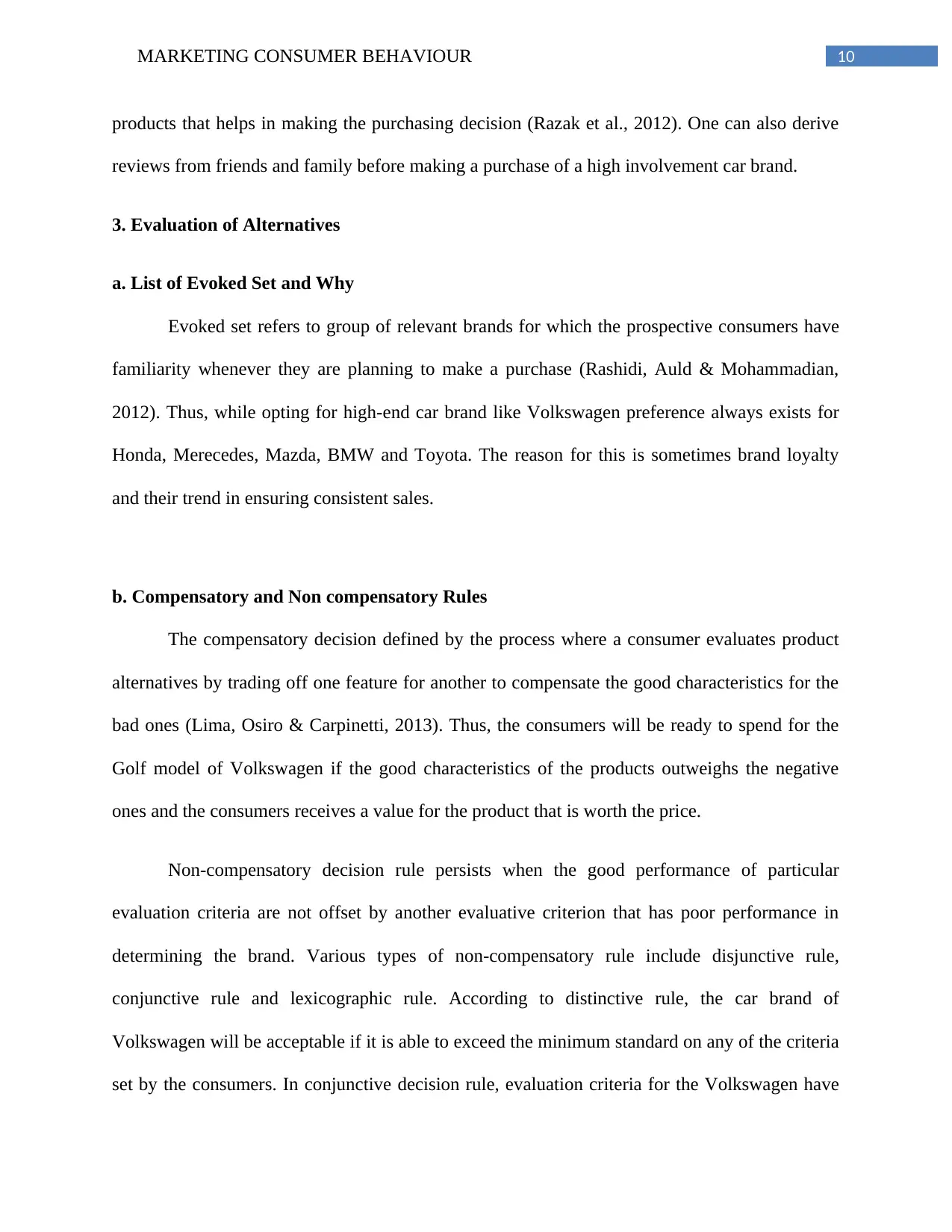
10MARKETING CONSUMER BEHAVIOUR
products that helps in making the purchasing decision (Razak et al., 2012). One can also derive
reviews from friends and family before making a purchase of a high involvement car brand.
3. Evaluation of Alternatives
a. List of Evoked Set and Why
Evoked set refers to group of relevant brands for which the prospective consumers have
familiarity whenever they are planning to make a purchase (Rashidi, Auld & Mohammadian,
2012). Thus, while opting for high-end car brand like Volkswagen preference always exists for
Honda, Merecedes, Mazda, BMW and Toyota. The reason for this is sometimes brand loyalty
and their trend in ensuring consistent sales.
b. Compensatory and Non compensatory Rules
The compensatory decision defined by the process where a consumer evaluates product
alternatives by trading off one feature for another to compensate the good characteristics for the
bad ones (Lima, Osiro & Carpinetti, 2013). Thus, the consumers will be ready to spend for the
Golf model of Volkswagen if the good characteristics of the products outweighs the negative
ones and the consumers receives a value for the product that is worth the price.
Non-compensatory decision rule persists when the good performance of particular
evaluation criteria are not offset by another evaluative criterion that has poor performance in
determining the brand. Various types of non-compensatory rule include disjunctive rule,
conjunctive rule and lexicographic rule. According to distinctive rule, the car brand of
Volkswagen will be acceptable if it is able to exceed the minimum standard on any of the criteria
set by the consumers. In conjunctive decision rule, evaluation criteria for the Volkswagen have
products that helps in making the purchasing decision (Razak et al., 2012). One can also derive
reviews from friends and family before making a purchase of a high involvement car brand.
3. Evaluation of Alternatives
a. List of Evoked Set and Why
Evoked set refers to group of relevant brands for which the prospective consumers have
familiarity whenever they are planning to make a purchase (Rashidi, Auld & Mohammadian,
2012). Thus, while opting for high-end car brand like Volkswagen preference always exists for
Honda, Merecedes, Mazda, BMW and Toyota. The reason for this is sometimes brand loyalty
and their trend in ensuring consistent sales.
b. Compensatory and Non compensatory Rules
The compensatory decision defined by the process where a consumer evaluates product
alternatives by trading off one feature for another to compensate the good characteristics for the
bad ones (Lima, Osiro & Carpinetti, 2013). Thus, the consumers will be ready to spend for the
Golf model of Volkswagen if the good characteristics of the products outweighs the negative
ones and the consumers receives a value for the product that is worth the price.
Non-compensatory decision rule persists when the good performance of particular
evaluation criteria are not offset by another evaluative criterion that has poor performance in
determining the brand. Various types of non-compensatory rule include disjunctive rule,
conjunctive rule and lexicographic rule. According to distinctive rule, the car brand of
Volkswagen will be acceptable if it is able to exceed the minimum standard on any of the criteria
set by the consumers. In conjunctive decision rule, evaluation criteria for the Volkswagen have
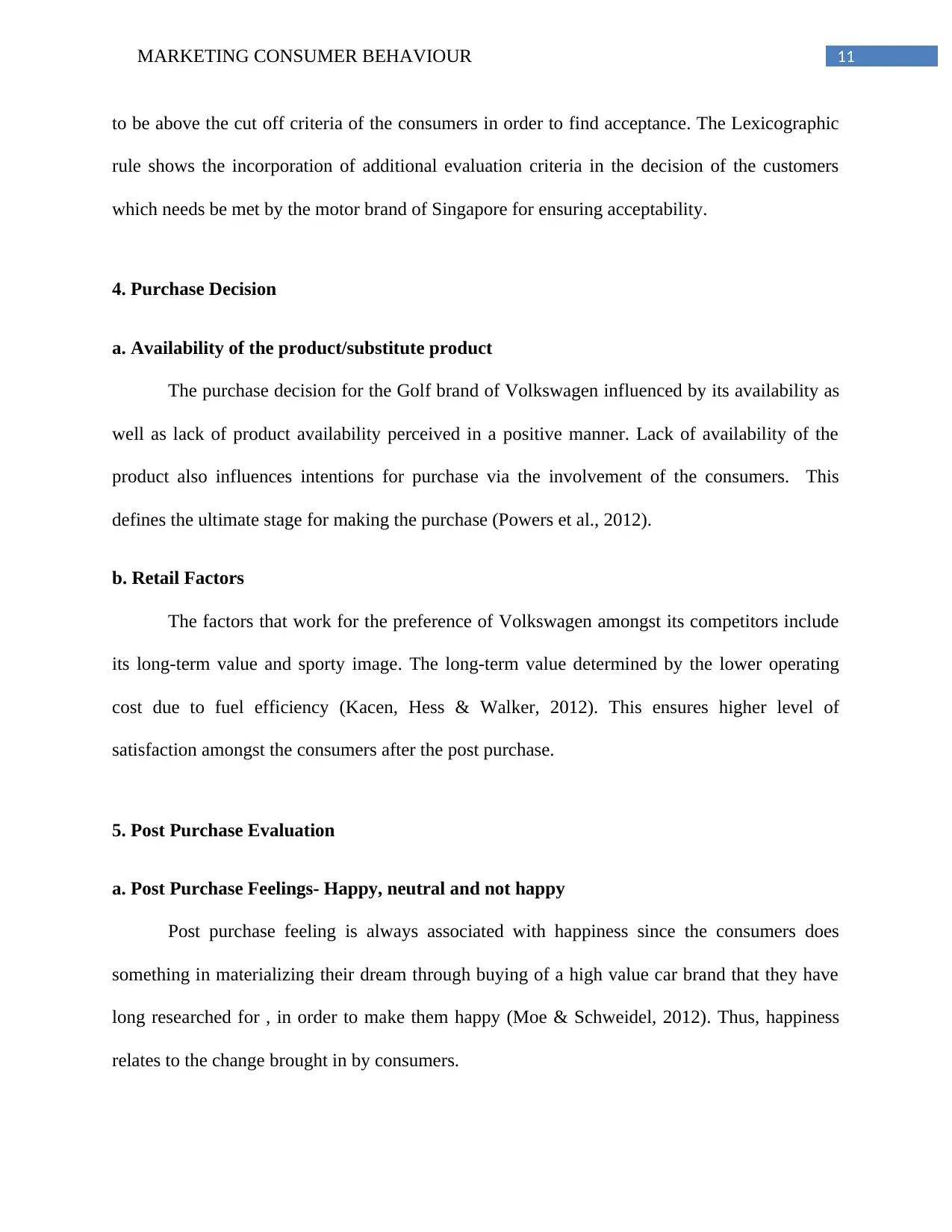
11MARKETING CONSUMER BEHAVIOUR
to be above the cut off criteria of the consumers in order to find acceptance. The Lexicographic
rule shows the incorporation of additional evaluation criteria in the decision of the customers
which needs be met by the motor brand of Singapore for ensuring acceptability.
4. Purchase Decision
a. Availability of the product/substitute product
The purchase decision for the Golf brand of Volkswagen influenced by its availability as
well as lack of product availability perceived in a positive manner. Lack of availability of the
product also influences intentions for purchase via the involvement of the consumers. This
defines the ultimate stage for making the purchase (Powers et al., 2012).
b. Retail Factors
The factors that work for the preference of Volkswagen amongst its competitors include
its long-term value and sporty image. The long-term value determined by the lower operating
cost due to fuel efficiency (Kacen, Hess & Walker, 2012). This ensures higher level of
satisfaction amongst the consumers after the post purchase.
5. Post Purchase Evaluation
a. Post Purchase Feelings- Happy, neutral and not happy
Post purchase feeling is always associated with happiness since the consumers does
something in materializing their dream through buying of a high value car brand that they have
long researched for , in order to make them happy (Moe & Schweidel, 2012). Thus, happiness
relates to the change brought in by consumers.
to be above the cut off criteria of the consumers in order to find acceptance. The Lexicographic
rule shows the incorporation of additional evaluation criteria in the decision of the customers
which needs be met by the motor brand of Singapore for ensuring acceptability.
4. Purchase Decision
a. Availability of the product/substitute product
The purchase decision for the Golf brand of Volkswagen influenced by its availability as
well as lack of product availability perceived in a positive manner. Lack of availability of the
product also influences intentions for purchase via the involvement of the consumers. This
defines the ultimate stage for making the purchase (Powers et al., 2012).
b. Retail Factors
The factors that work for the preference of Volkswagen amongst its competitors include
its long-term value and sporty image. The long-term value determined by the lower operating
cost due to fuel efficiency (Kacen, Hess & Walker, 2012). This ensures higher level of
satisfaction amongst the consumers after the post purchase.
5. Post Purchase Evaluation
a. Post Purchase Feelings- Happy, neutral and not happy
Post purchase feeling is always associated with happiness since the consumers does
something in materializing their dream through buying of a high value car brand that they have
long researched for , in order to make them happy (Moe & Schweidel, 2012). Thus, happiness
relates to the change brought in by consumers.

12MARKETING CONSUMER BEHAVIOUR
b. Post purchase cognitive dissonance and handling Consumers and Marketers Point of
view
Cognitive dissonance is a kind of remorse that buyers express after post purchase. This is
purchase anxiety or psychological tension (Chou, 2012). It is at this stage where the consumers
feel whether the purchase decision has been correct.
The dissatisfaction of the consumers might rise due to a complaint behavior. Therefore,
the consumer prompted for taking actions against the marketers or service providers through
product return, warning friends, switching of brands, complaining to marketer or taking legal
action against him.
On the other hand, the marketers should follow the complaints of the consumers for
measuring how their performance gets perceive by the consumers and thereby make necessary
changes in enhancing their service to the consumers. Therefore, marketers can use this customer
feedback for improving the quality of their products
6. Two Social Influences
a. Family - Family Decision Making Process
Individual family members serve a role in the process decision making of consumes.
Some members of the family try to enlighten the consumers about the positive and negative sides
about buying a product (Solomon, Russell-Bennett & Previte, 2012). Thus, the influence of the
family has an impact on the consumers that forces them to think whether to make a buy.
b. Post purchase cognitive dissonance and handling Consumers and Marketers Point of
view
Cognitive dissonance is a kind of remorse that buyers express after post purchase. This is
purchase anxiety or psychological tension (Chou, 2012). It is at this stage where the consumers
feel whether the purchase decision has been correct.
The dissatisfaction of the consumers might rise due to a complaint behavior. Therefore,
the consumer prompted for taking actions against the marketers or service providers through
product return, warning friends, switching of brands, complaining to marketer or taking legal
action against him.
On the other hand, the marketers should follow the complaints of the consumers for
measuring how their performance gets perceive by the consumers and thereby make necessary
changes in enhancing their service to the consumers. Therefore, marketers can use this customer
feedback for improving the quality of their products
6. Two Social Influences
a. Family - Family Decision Making Process
Individual family members serve a role in the process decision making of consumes.
Some members of the family try to enlighten the consumers about the positive and negative sides
about buying a product (Solomon, Russell-Bennett & Previte, 2012). Thus, the influence of the
family has an impact on the consumers that forces them to think whether to make a buy.
Paraphrase This Document
Need a fresh take? Get an instant paraphrase of this document with our AI Paraphraser

13MARKETING CONSUMER BEHAVIOUR
b. Social Class- Influence of Social Class on Decision Making Process
The social group in which the individual belongs defines his social class that influences
his buying decision. Social class defined by people who have same values, behavior and
lifestyle. Thus, this similarity in social class also calls for the possession of similar buying
behavior though the influence level might be higher or lower (Solomon, 2014). The marketer can
therefore tailor the marketing activities according to the social classes of the targeted consumers.
7. Psychological Influences
a. Motivation
Motivation activates the internal requirement and needs of the consumer. This also refers
to the needs and goals of the consumers (Lysonski & Durvasula, 2013). It is therefore motivation
that directs and arouses the consumers to particular goals.
b. Perception
Perception refers to sensing the situations around as well the world and then takes
necessary decisions accordingly. Everyone has a different perception based on which they look
at situations (Song et al., 2012). Therefore, the capacity of every individual and their judging
ability varies along with their perception and impacts on influencing the purchase decision of the
consumers.
c. Learning
Learning is also possible to achieve through experience. The information about a product
is only available to an individual only after its usage (Mihart, 2012). Thus, a consumer who is
utterly satisfied with the product will possess a higher inclination towards buying the similar
products for the second time.
b. Social Class- Influence of Social Class on Decision Making Process
The social group in which the individual belongs defines his social class that influences
his buying decision. Social class defined by people who have same values, behavior and
lifestyle. Thus, this similarity in social class also calls for the possession of similar buying
behavior though the influence level might be higher or lower (Solomon, 2014). The marketer can
therefore tailor the marketing activities according to the social classes of the targeted consumers.
7. Psychological Influences
a. Motivation
Motivation activates the internal requirement and needs of the consumer. This also refers
to the needs and goals of the consumers (Lysonski & Durvasula, 2013). It is therefore motivation
that directs and arouses the consumers to particular goals.
b. Perception
Perception refers to sensing the situations around as well the world and then takes
necessary decisions accordingly. Everyone has a different perception based on which they look
at situations (Song et al., 2012). Therefore, the capacity of every individual and their judging
ability varies along with their perception and impacts on influencing the purchase decision of the
consumers.
c. Learning
Learning is also possible to achieve through experience. The information about a product
is only available to an individual only after its usage (Mihart, 2012). Thus, a consumer who is
utterly satisfied with the product will possess a higher inclination towards buying the similar
products for the second time.
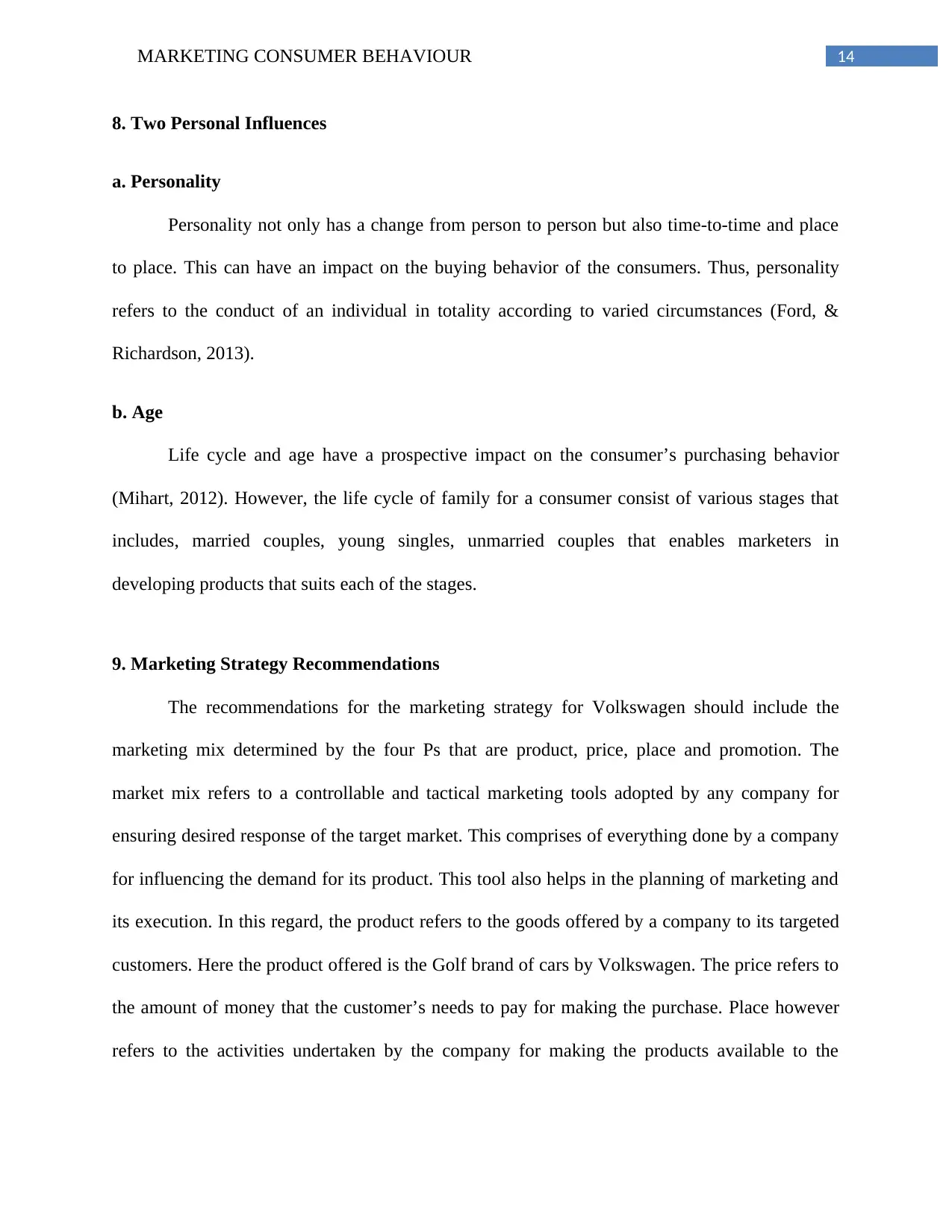
14MARKETING CONSUMER BEHAVIOUR
8. Two Personal Influences
a. Personality
Personality not only has a change from person to person but also time-to-time and place
to place. This can have an impact on the buying behavior of the consumers. Thus, personality
refers to the conduct of an individual in totality according to varied circumstances (Ford, &
Richardson, 2013).
b. Age
Life cycle and age have a prospective impact on the consumer’s purchasing behavior
(Mihart, 2012). However, the life cycle of family for a consumer consist of various stages that
includes, married couples, young singles, unmarried couples that enables marketers in
developing products that suits each of the stages.
9. Marketing Strategy Recommendations
The recommendations for the marketing strategy for Volkswagen should include the
marketing mix determined by the four Ps that are product, price, place and promotion. The
market mix refers to a controllable and tactical marketing tools adopted by any company for
ensuring desired response of the target market. This comprises of everything done by a company
for influencing the demand for its product. This tool also helps in the planning of marketing and
its execution. In this regard, the product refers to the goods offered by a company to its targeted
customers. Here the product offered is the Golf brand of cars by Volkswagen. The price refers to
the amount of money that the customer’s needs to pay for making the purchase. Place however
refers to the activities undertaken by the company for making the products available to the
8. Two Personal Influences
a. Personality
Personality not only has a change from person to person but also time-to-time and place
to place. This can have an impact on the buying behavior of the consumers. Thus, personality
refers to the conduct of an individual in totality according to varied circumstances (Ford, &
Richardson, 2013).
b. Age
Life cycle and age have a prospective impact on the consumer’s purchasing behavior
(Mihart, 2012). However, the life cycle of family for a consumer consist of various stages that
includes, married couples, young singles, unmarried couples that enables marketers in
developing products that suits each of the stages.
9. Marketing Strategy Recommendations
The recommendations for the marketing strategy for Volkswagen should include the
marketing mix determined by the four Ps that are product, price, place and promotion. The
market mix refers to a controllable and tactical marketing tools adopted by any company for
ensuring desired response of the target market. This comprises of everything done by a company
for influencing the demand for its product. This tool also helps in the planning of marketing and
its execution. In this regard, the product refers to the goods offered by a company to its targeted
customers. Here the product offered is the Golf brand of cars by Volkswagen. The price refers to
the amount of money that the customer’s needs to pay for making the purchase. Place however
refers to the activities undertaken by the company for making the products available to the
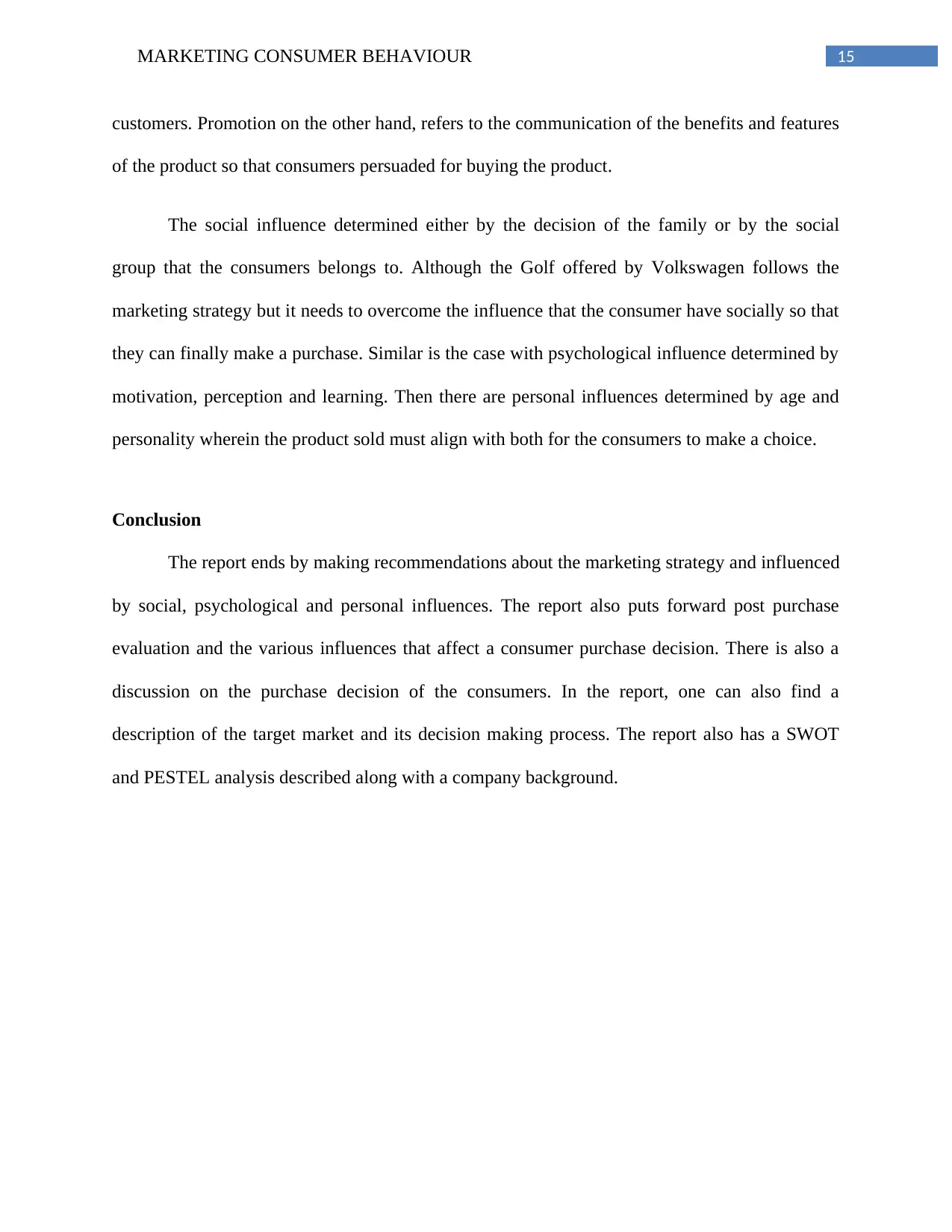
15MARKETING CONSUMER BEHAVIOUR
customers. Promotion on the other hand, refers to the communication of the benefits and features
of the product so that consumers persuaded for buying the product.
The social influence determined either by the decision of the family or by the social
group that the consumers belongs to. Although the Golf offered by Volkswagen follows the
marketing strategy but it needs to overcome the influence that the consumer have socially so that
they can finally make a purchase. Similar is the case with psychological influence determined by
motivation, perception and learning. Then there are personal influences determined by age and
personality wherein the product sold must align with both for the consumers to make a choice.
Conclusion
The report ends by making recommendations about the marketing strategy and influenced
by social, psychological and personal influences. The report also puts forward post purchase
evaluation and the various influences that affect a consumer purchase decision. There is also a
discussion on the purchase decision of the consumers. In the report, one can also find a
description of the target market and its decision making process. The report also has a SWOT
and PESTEL analysis described along with a company background.
customers. Promotion on the other hand, refers to the communication of the benefits and features
of the product so that consumers persuaded for buying the product.
The social influence determined either by the decision of the family or by the social
group that the consumers belongs to. Although the Golf offered by Volkswagen follows the
marketing strategy but it needs to overcome the influence that the consumer have socially so that
they can finally make a purchase. Similar is the case with psychological influence determined by
motivation, perception and learning. Then there are personal influences determined by age and
personality wherein the product sold must align with both for the consumers to make a choice.
Conclusion
The report ends by making recommendations about the marketing strategy and influenced
by social, psychological and personal influences. The report also puts forward post purchase
evaluation and the various influences that affect a consumer purchase decision. There is also a
discussion on the purchase decision of the consumers. In the report, one can also find a
description of the target market and its decision making process. The report also has a SWOT
and PESTEL analysis described along with a company background.
Secure Best Marks with AI Grader
Need help grading? Try our AI Grader for instant feedback on your assignments.
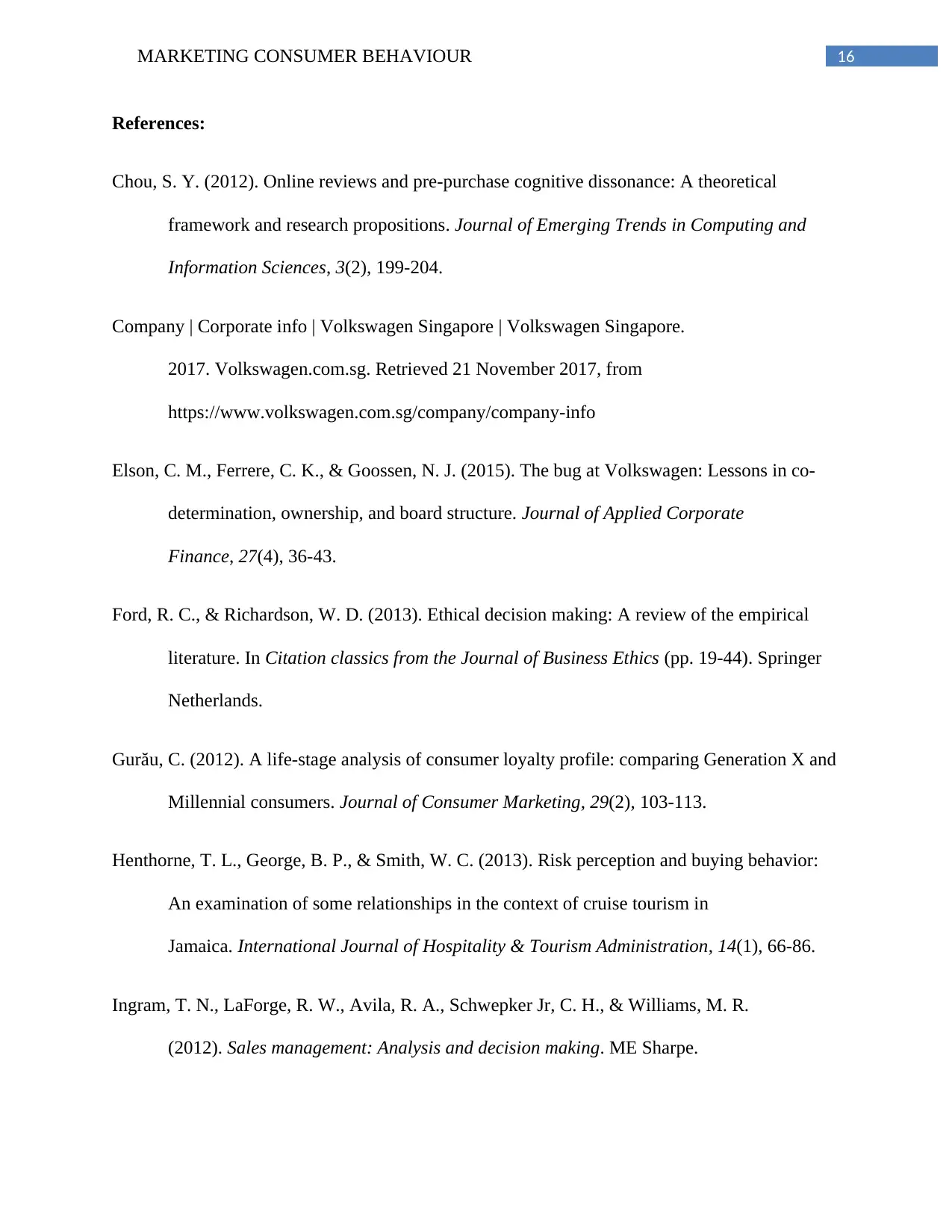
16MARKETING CONSUMER BEHAVIOUR
References:
Chou, S. Y. (2012). Online reviews and pre-purchase cognitive dissonance: A theoretical
framework and research propositions. Journal of Emerging Trends in Computing and
Information Sciences, 3(2), 199-204.
Company | Corporate info | Volkswagen Singapore | Volkswagen Singapore.
2017. Volkswagen.com.sg. Retrieved 21 November 2017, from
https://www.volkswagen.com.sg/company/company-info
Elson, C. M., Ferrere, C. K., & Goossen, N. J. (2015). The bug at Volkswagen: Lessons in co‐
determination, ownership, and board structure. Journal of Applied Corporate
Finance, 27(4), 36-43.
Ford, R. C., & Richardson, W. D. (2013). Ethical decision making: A review of the empirical
literature. In Citation classics from the Journal of Business Ethics (pp. 19-44). Springer
Netherlands.
Gurău, C. (2012). A life-stage analysis of consumer loyalty profile: comparing Generation X and
Millennial consumers. Journal of Consumer Marketing, 29(2), 103-113.
Henthorne, T. L., George, B. P., & Smith, W. C. (2013). Risk perception and buying behavior:
An examination of some relationships in the context of cruise tourism in
Jamaica. International Journal of Hospitality & Tourism Administration, 14(1), 66-86.
Ingram, T. N., LaForge, R. W., Avila, R. A., Schwepker Jr, C. H., & Williams, M. R.
(2012). Sales management: Analysis and decision making. ME Sharpe.
References:
Chou, S. Y. (2012). Online reviews and pre-purchase cognitive dissonance: A theoretical
framework and research propositions. Journal of Emerging Trends in Computing and
Information Sciences, 3(2), 199-204.
Company | Corporate info | Volkswagen Singapore | Volkswagen Singapore.
2017. Volkswagen.com.sg. Retrieved 21 November 2017, from
https://www.volkswagen.com.sg/company/company-info
Elson, C. M., Ferrere, C. K., & Goossen, N. J. (2015). The bug at Volkswagen: Lessons in co‐
determination, ownership, and board structure. Journal of Applied Corporate
Finance, 27(4), 36-43.
Ford, R. C., & Richardson, W. D. (2013). Ethical decision making: A review of the empirical
literature. In Citation classics from the Journal of Business Ethics (pp. 19-44). Springer
Netherlands.
Gurău, C. (2012). A life-stage analysis of consumer loyalty profile: comparing Generation X and
Millennial consumers. Journal of Consumer Marketing, 29(2), 103-113.
Henthorne, T. L., George, B. P., & Smith, W. C. (2013). Risk perception and buying behavior:
An examination of some relationships in the context of cruise tourism in
Jamaica. International Journal of Hospitality & Tourism Administration, 14(1), 66-86.
Ingram, T. N., LaForge, R. W., Avila, R. A., Schwepker Jr, C. H., & Williams, M. R.
(2012). Sales management: Analysis and decision making. ME Sharpe.

17MARKETING CONSUMER BEHAVIOUR
Kacen, J. J., Hess, J. D., & Walker, D. (2012). Spontaneous selection: The influence of product
and retailing factors on consumer impulse purchases. Journal of Retailing and Consumer
Services, 19(6), 578-588.
Kagali, L. (2014). Emotion design of an iconic (volkswagen) Campervan.
Lima, F. R., Osiro, L., & Carpinetti, L. C. R. (2013). A fuzzy inference and categorization
approach for supplier selection using compensatory and non-compensatory decision
rules. Applied Soft Computing, 13(10), 4133-4147.
Lysonski, S., & Durvasula, S. (2013). Consumer decision making styles in retailing: evolution of
mindsets and psychological impacts. Journal of Consumer Marketing, 30(1), 75-87.
Mihart, C. (2012). Impact of integrated marketing communication on consumer behaviour:
effects on consumer decision–making process. International Journal of Marketing
Studies, 4(2), 121.
Moe, W. W., & Schweidel, D. A. (2012). Online product opinions: Incidence, evaluation, and
evolution. Marketing Science, 31(3), 372-386.
Powers, T., Advincula, D., Austin, M. S., Graiko, S., & Snyder, J. (2012). Digital and social
media in the purchase decision process. Journal of advertising research, 52(4), 479-489.
Rashidi, T. H., Auld, J., & Mohammadian, A. K. (2012). A behavioral housing search model:
Two-stage hazard-based and multinomial logit approach to choice-set formation and
location selection. Transportation Research Part A: Policy and Practice, 46(7), 1097-
1107.
Kacen, J. J., Hess, J. D., & Walker, D. (2012). Spontaneous selection: The influence of product
and retailing factors on consumer impulse purchases. Journal of Retailing and Consumer
Services, 19(6), 578-588.
Kagali, L. (2014). Emotion design of an iconic (volkswagen) Campervan.
Lima, F. R., Osiro, L., & Carpinetti, L. C. R. (2013). A fuzzy inference and categorization
approach for supplier selection using compensatory and non-compensatory decision
rules. Applied Soft Computing, 13(10), 4133-4147.
Lysonski, S., & Durvasula, S. (2013). Consumer decision making styles in retailing: evolution of
mindsets and psychological impacts. Journal of Consumer Marketing, 30(1), 75-87.
Mihart, C. (2012). Impact of integrated marketing communication on consumer behaviour:
effects on consumer decision–making process. International Journal of Marketing
Studies, 4(2), 121.
Moe, W. W., & Schweidel, D. A. (2012). Online product opinions: Incidence, evaluation, and
evolution. Marketing Science, 31(3), 372-386.
Powers, T., Advincula, D., Austin, M. S., Graiko, S., & Snyder, J. (2012). Digital and social
media in the purchase decision process. Journal of advertising research, 52(4), 479-489.
Rashidi, T. H., Auld, J., & Mohammadian, A. K. (2012). A behavioral housing search model:
Two-stage hazard-based and multinomial logit approach to choice-set formation and
location selection. Transportation Research Part A: Policy and Practice, 46(7), 1097-
1107.

18MARKETING CONSUMER BEHAVIOUR
Razak, M. I., Ibrahim, R., Abdullah, N., Osman, I., & Alias, Z. (2013). Purchasing intention
towards real estate development in Setia Alam, Shah Alam: Evidence from
Malaysia. International Journal of Business, Humanities and Technology, 3(6), 66-75.
Rugraff, E. (2012). The new competitive advantage of automobile manufacturers. Journal of
Strategy and Management, 5(4), 407-419.
Solomon, M. R. (2014). Consumer behavior: Buying, having, and being (Vol. 10). Upper Saddle
River, NJ: Prentice Hall.
Solomon, M., Russell-Bennett, R., & Previte, J. (2012). Consumer behaviour. Pearson Higher
Education AU.
Song, H. J., Lee, C. K., Kang, S. K., & Boo, S. J. (2012). The effect of environmentally friendly
perceptions on festival visitors’ decision-making process using an extended model of
goal-directed behavior. Tourism Management, 33(6), 1417-1428.
Steilmann, L. (2014). An evaluation of joint venture as a mode of entry. The example of"
Volkswagen".
Volkswagen Singapore. 2017. Volkswagen.com.sg. Retrieved 21 November 2017, from
https://www.volkswagen.com.sg/
Razak, M. I., Ibrahim, R., Abdullah, N., Osman, I., & Alias, Z. (2013). Purchasing intention
towards real estate development in Setia Alam, Shah Alam: Evidence from
Malaysia. International Journal of Business, Humanities and Technology, 3(6), 66-75.
Rugraff, E. (2012). The new competitive advantage of automobile manufacturers. Journal of
Strategy and Management, 5(4), 407-419.
Solomon, M. R. (2014). Consumer behavior: Buying, having, and being (Vol. 10). Upper Saddle
River, NJ: Prentice Hall.
Solomon, M., Russell-Bennett, R., & Previte, J. (2012). Consumer behaviour. Pearson Higher
Education AU.
Song, H. J., Lee, C. K., Kang, S. K., & Boo, S. J. (2012). The effect of environmentally friendly
perceptions on festival visitors’ decision-making process using an extended model of
goal-directed behavior. Tourism Management, 33(6), 1417-1428.
Steilmann, L. (2014). An evaluation of joint venture as a mode of entry. The example of"
Volkswagen".
Volkswagen Singapore. 2017. Volkswagen.com.sg. Retrieved 21 November 2017, from
https://www.volkswagen.com.sg/
1 out of 19
![[object Object]](/_next/static/media/star-bottom.7253800d.svg)





